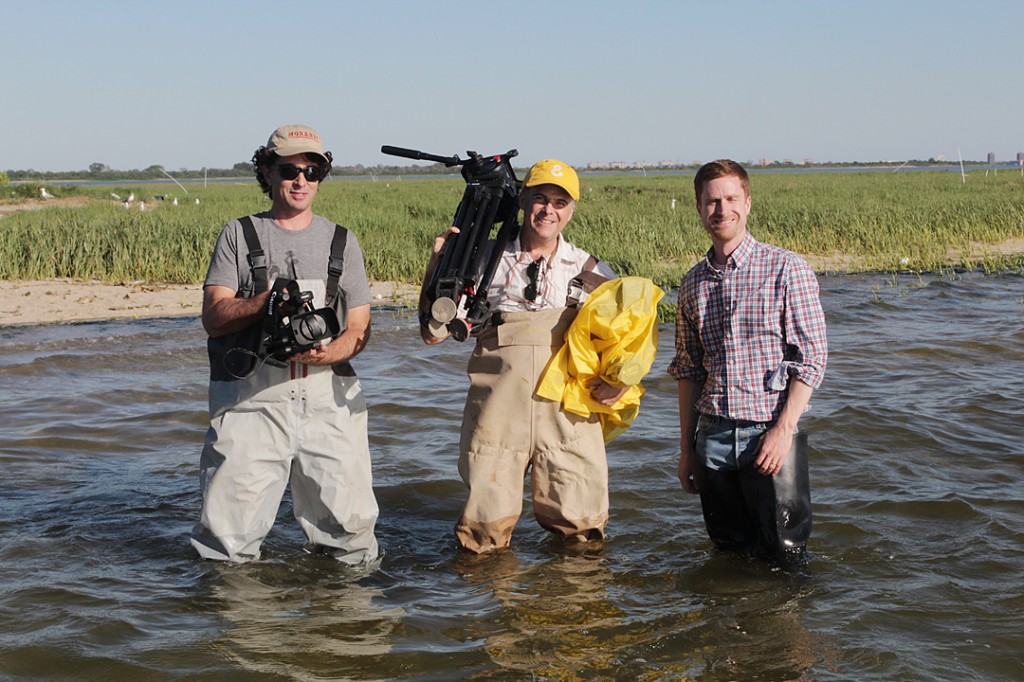November 14, 2013

Director David Sigal, wildlife cameraman Dan Gold, and Project Founder Dan Hendrick work on their feature-length documentary, “Jamaica Bay Lives.” Photo Courtesy Don Riepe
Conservationist Dan Hendrick is reaching out to the Queens community for home videos, smart phone footage, and still photographs of residents preparing for Superstorm Sandy, as well as images of the hurricane’s aftermath, for use in his forthcoming documentary, “Jamaica Bay Lives.”
The filmmaker began shooting in 2011, a full year before Superstorm Sandy ravaged the bay and its surrounding neighborhoods at the end of October last year. Hendrick said the event dramatically reshaped the storyline of his film, which he now describes as “Sandy plus one.”
“After Superstorm Sandy, people are looking at Jamaica Bay with fresh eyes,” Hendrick said. “We’ve been capturing that.”
The project is slated to become the first-ever feature length documentary about the urban estuary, which lays claim to the duel titles of largest outdoor space in New York City and the only wildlife refuge in the country that is accessible by subway.
A Queens transplant by way of Michigan, Hendrick has spent nearly two decades living in the borough and previously authored a book on the bay for Arcadia Publishing’s “Images of America” series.
“I grew up with the Great Lakes, and that always had me connected to water issues,” Hendrick said.
The longtime environmentalist easily recalls his first trip to Jamaica Bay and its powerful initial impression on him.
“’Who knew this was here?’” he remembered thinking.
Almost 20 years later, many New Yorkers are still shocked to learn that such crucial wildlife habitat exists on their doorstep.
“The biggest reaction people have when I show them is surprise,” Hendrick said.
According to Hendrick, Jamaica Bay is “shaping up to be a laboratory for ideas” in the wake of Superstorm Sandy. The fight to restore the salt marshes and protect the bay from JFK International Airport’s proposed expansion has garnered increased attention due to recent interest in environmental management’s potential role in combating global climate change.
Filling, dredging, illegal dumping, leakage from three nearby inactive landfills, and nitrogen discharge from sewage treatment plants have long plagued the site, which provides nesting ground for hundreds of species of migratory birds.
Hendrick is first to admit that he’s new to the medium of documentary filmmaking, but says he was fortunate to have “plugged into a really professional crew,” including director and cinematographer David Sigal and editor Trevor Laurence.
The filmmakers plan to wrap principal photography for the project in the next few weeks. Those hoping to catch a glimpse of the documentary in the meantime can check out the official extended trailer Hendrick posted to his Youtube channel in January.
“Jamaica Bay Lives” is funded, in part, by a small grant from Queens Council for the Arts and is sponsored by the New York City Audubon Society. Hendrick says he will seek major institutional support once the film is completed. Donations from individuals can be made at https://ioby.org/project/jamaica-bay-lives.
Community members interested in sharing images and videos of Superstorm Sandy can get in touch with Dan Hendrick at (917) 207-8715 or jamaicabaylives@gmail.com.
“We’ll give them full credit,” Hendrick said.
By Hannah Sheehan
November 14, 2013

Director David Sigal, wildlife cameraman Dan Gold, and Project Founder Dan Hendrick work on their feature-length documentary, “Jamaica Bay Lives.” Photo Courtesy Don Riepe


No comments:
Post a Comment